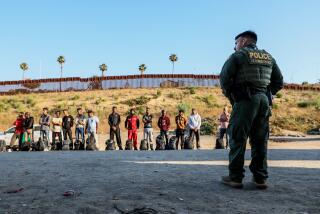Does the Constitution protect someone on the Mexican side of the border?

The Court’s decision in Hernandez vs. Mesa will try to answer the question: Does the Constitution protect foreign citizens who stand at the nation’s borders? (Feb. 21, 2017)
Reporting from Washington — The Supreme Court on Tuesday will take up the case of a Mexican teenager who was shot and killed by a U.S. border agent and try to decide a question that is also at the heart of the legal dispute over President Trump’s foreign travel ban: Does the Constitution protect foreign citizens who stand at the nation’s borders?
Judges have blocked Trump’s order temporarily on the grounds it may violate the constitutional rights of foreign travelers from seven Muslim majority nations. Some of those foreigners live legally in this country and had traveled abroad, while others hold U.S. visas but have never been to the United States. However, the law in this area is far from clear, and it will likely remain so until the high court rules on the issue.
The border shooting case touches on a similar question, and the outcome may affect the travel ban litigation.
In June 2010, Sergio Hernandez, 15, was playing with two friends in the concrete culvert that marks the boundary between El Paso and Juarez, Mexico. Cellphone video shows the boys ran up the culvert on the U.S. side and touched the high fence. They turned to run back to the Mexican side when a U.S. border patrol agent on a bicycle came upon them.
Officer Jesus Mesa Jr. grabbed one of the boys and turned his gun toward the other, Sergio, who had hidden behind a pillar about 60 feet away on the Mexican side. The officer fired three shots and killed the teenager.
Mesa initially claimed he acted in self-defense because the boys were throwing rocks at him. While the video appeared to disprove that, Justice Department investigators later said Mesa was responding to reports of smugglers and he had encountered rocks being thrown.
The killing of the teenager, who was unarmed and posed no apparent threat to the officer, provoked anger on the Mexican side of the border, but U.S. officials refused to extradite Mesa to face charges in Mexico. They also decided against prosecuting him under U.S. law.
Sergio’s parents then sued Mesa, alleging the shooting was an unjustified violation of the Constitution. They cited the 4th Amendment’s ban on unreasonable seizures and the use of excessive force as well as the 5th Amendment, which says no person shall “be deprived of life or liberty … without due process of law.”
A federal judge threw out the suit on the grounds that the Constitution’s protections stop at the border. Since the Mexican teenager was killed on the Mexican side, his family could not sue the border patrol agent, the judge said.
A divided panel of the U.S. 5th Circuit Court of Appeals briefly revived the suit. The majority cited the Supreme Court’s ruling in cases regarding the U.S. detention facility at Guantanamo Bay, Cuba, in which the justices said the Constitution and the right to habeas corpus extended to the naval base on Cuban soil because U.S. authorities exercised complete control there. Similarly, the judges said, U.S. agents controlled the area on the U.S-Mexico border.
The full 15-member appeals court then took up the case and decided that because the law was not clear, the border agent could not be held liable for violating it.
The family appealed to the Supreme Court, arguing the justices should not permit a “law-free zone in which U.S. agents can kill innocent civilians with impunity.”
The case of Hernandez vs. Mesa will be the first argued in the Supreme Court by lawyers representing the Trump administration.
In an interview, the family’s attorney, Robert Hilliard of Corpus Christi, Texas, said the case has similarities to the legal battle over Trump’s travel ban. “This is really about the separation of powers and whether the judiciary has a role in reviewing the conduct of the government,” he said.
He was referring to the government’s contention in the border shooting case that the Supreme Court should throw out the suit and shield U.S. agents from all such claims.
Defending the travel ban, government lawyers made a similar argument, contending judges had no authority to second-guess the president’s decision to exclude certain foreigners from entering the country. Last weekend, White House policy advisor Stephen Miller said in TV interviews that judges had no authority to block Trump’s order on foreign travelers. “The president’s powers here are beyond question,” he said. “We don’t have judicial supremacy in this country.”
As usual, Justice Anthony M. Kennedy appears to hold the key vote. In the past, he has said the reach of the Constitution should turn on practical concerns, including whether U.S. officials are in control. If so, he could join with the court’s liberals to say the Constitution constrains U.S. agents operating on a border, thereby clearing the family’s lawsuit to proceed. Such a decision would surely be cited by lawyers and judges in the litigation over the travel ban.
But he could also join with the court’s conservatives and refuse to open the door for noncitizens outside the country to bring legal claims against U.S. officials. If the court were to split, 4-4, the justices could choose to place a hold on the case and await the confirmation of a ninth justice.
The Senate will begin hearings March 20 on Judge Neil Gorsuch, the president’s nominee to fill the vacancy.
On Twitter: DavidGSavage
ALSO:
Democrats and liberal activists face uphill battle against Supreme Court nominee Neil Gorsuch
Supreme Court may look for a middle ground on Trump’s travel ban by shielding only certain travelers
Scalia’s views mixed with Kennedy’s style: Meet Neil Gorsuch, Trump’s pick for the Supreme Court
More to Read
Get the L.A. Times Politics newsletter
Deeply reported insights into legislation, politics and policy from Sacramento, Washington and beyond. In your inbox three times per week.
You may occasionally receive promotional content from the Los Angeles Times.











